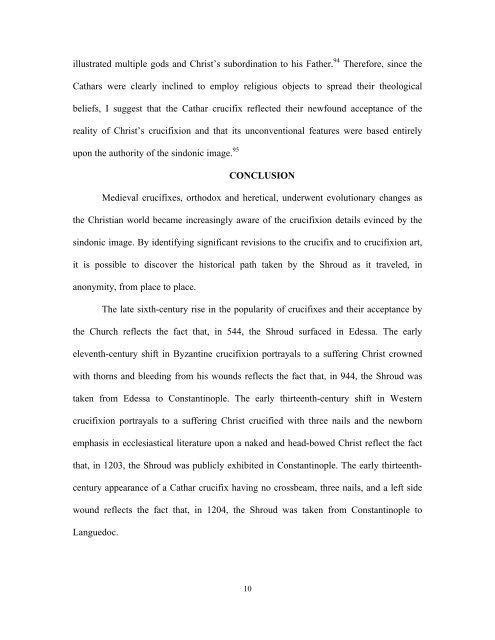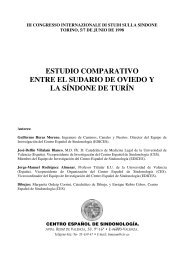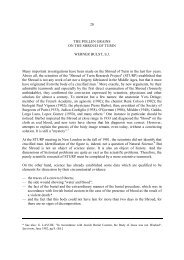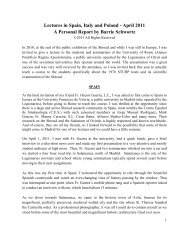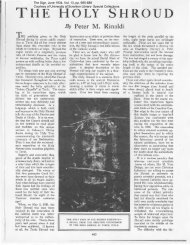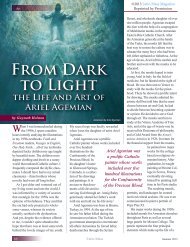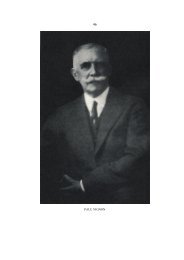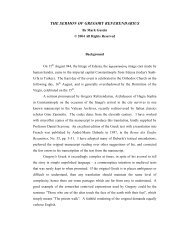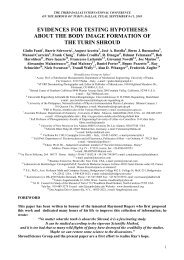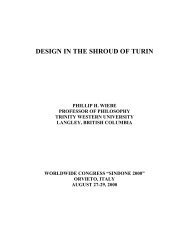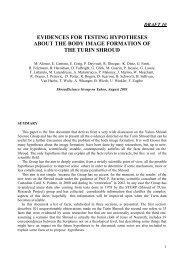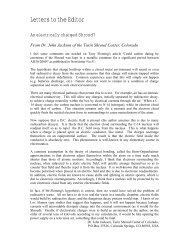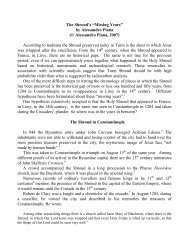the cathar crucifix - The Shroud of Turin
the cathar crucifix - The Shroud of Turin
the cathar crucifix - The Shroud of Turin
Create successful ePaper yourself
Turn your PDF publications into a flip-book with our unique Google optimized e-Paper software.
illustrated multiple gods and Christ’s subordination to his Fa<strong>the</strong>r. 94 <strong>The</strong>refore, since <strong>the</strong><br />
Cathars were clearly inclined to employ religious objects to spread <strong>the</strong>ir <strong>the</strong>ological<br />
beliefs, I suggest that <strong>the</strong> Cathar <strong>crucifix</strong> reflected <strong>the</strong>ir newfound acceptance <strong>of</strong> <strong>the</strong><br />
reality <strong>of</strong> Christ’s <strong>crucifix</strong>ion and that its unconventional features were based entirely<br />
upon <strong>the</strong> authority <strong>of</strong> <strong>the</strong> sindonic image. 95<br />
CONCLUSION<br />
Medieval <strong>crucifix</strong>es, orthodox and heretical, underwent evolutionary changes as<br />
<strong>the</strong> Christian world became increasingly aware <strong>of</strong> <strong>the</strong> <strong>crucifix</strong>ion details evinced by <strong>the</strong><br />
sindonic image. By identifying significant revisions to <strong>the</strong> <strong>crucifix</strong> and to <strong>crucifix</strong>ion art,<br />
it is possible to discover <strong>the</strong> historical path taken by <strong>the</strong> <strong>Shroud</strong> as it traveled, in<br />
anonymity, from place to place.<br />
<strong>The</strong> late sixth-century rise in <strong>the</strong> popularity <strong>of</strong> <strong>crucifix</strong>es and <strong>the</strong>ir acceptance by<br />
<strong>the</strong> Church reflects <strong>the</strong> fact that, in 544, <strong>the</strong> <strong>Shroud</strong> surfaced in Edessa. <strong>The</strong> early<br />
eleventh-century shift in Byzantine <strong>crucifix</strong>ion portrayals to a suffering Christ crowned<br />
with thorns and bleeding from his wounds reflects <strong>the</strong> fact that, in 944, <strong>the</strong> <strong>Shroud</strong> was<br />
taken from Edessa to Constantinople. <strong>The</strong> early thirteenth-century shift in Western<br />
<strong>crucifix</strong>ion portrayals to a suffering Christ crucified with three nails and <strong>the</strong> newborn<br />
emphasis in ecclesiastical literature upon a naked and head-bowed Christ reflect <strong>the</strong> fact<br />
that, in 1203, <strong>the</strong> <strong>Shroud</strong> was publicly exhibited in Constantinople. <strong>The</strong> early thirteenth-<br />
century appearance <strong>of</strong> a Cathar <strong>crucifix</strong> having no crossbeam, three nails, and a left side<br />
wound reflects <strong>the</strong> fact that, in 1204, <strong>the</strong> <strong>Shroud</strong> was taken from Constantinople to<br />
Languedoc.<br />
10


